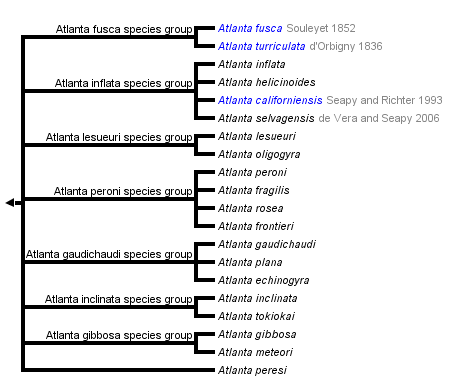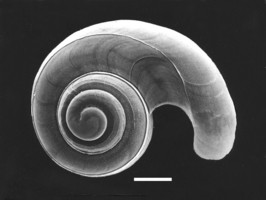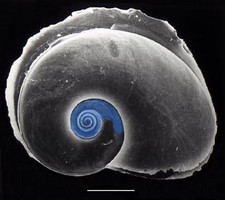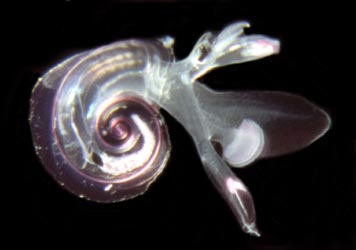Atlanta
Roger R. Seapy


This tree diagram shows the relationships between several groups of organisms.
The root of the current tree connects the organisms featured in this tree to their containing group and the rest of the Tree of Life. The basal branching point in the tree represents the ancestor of the other groups in the tree. This ancestor diversified over time into several descendent subgroups, which are represented as internal nodes and terminal taxa to the right.

You can click on the root to travel down the Tree of Life all the way to the root of all Life, and you can click on the names of descendent subgroups to travel up the Tree of Life all the way to individual species.
For more information on ToL tree formatting, please see Interpreting the Tree or Classification. To learn more about phylogenetic trees, please visit our Phylogenetic Biology pages.
close boxIntroduction
Atlanta is the type genus of the Atlantidae, containing 20 of the 22 species in the family (the other two genera, Protatlanta and Oxygyrus, are monospecific). The shell and keel are calcareous (composed of aragonite). The larval shell is retained following metamorphosis, becoming the spire in the adult shell. All species but one, A. californiensis from the temperate North Pacific, are found in tropical to subtropical waters. Most (12) are cosmopolitan in geographic distribution, although three are Indo-Pacific, two are found only in the Indian Ocean, two only in the Atlantic Ocean, and one in the Pacific Ocean.
Brief Diagnosis
An atlantid with:
- Shell and keel calcareous
- Larval shell becomes spire of adult shell
Characteristics
- Eye morphology of three types: a, b and c (see Atlantidae page)
- Operculum morphology of three types: a, b, c (see Atlantidae page)
- Radular morphology of two types: I and II (see Pterotracheoidea page)
- Shell
- The shell consists of three sequentially-deposited portions; a dome-shaped embryonic shell (protoconch I) of about 3/4 whorl (see below left), a larval shell (protoconch II) of a variable number of whorls (see below middle), and the adult shell (teleoconch) of a variable number of whorls (see below right)
 Click on an image to view larger version & data in a new window
Click on an image to view larger version & data in a new window


Figure. Scanning electron micrographs of embryonic portion (protoconch I) of larval shell (left), larval shell (protoconch II; middle), and adult shell (right; protoconch shaded blue to distinguish it from the teleoconch) in Atlanta plana. Scale bars = 0.1 mm (middle) and 0.5 mm (right). © 2005
- Spire whorl number. The number of whorls comprising the spire of the adult shell (the protoconch) is constant, while the number of whorls in the teleoconch increases with shell growth (see above right). The size of the teleoconch whorls (reflected in the width of the whorls when the shell is viewed from the right side) increases rapidly with growth. Thus, the approximate location on the shell where the narrow whorls of the protoconch end and the rapidly increasing width of the teleoconch whorls begin is easily determined under a dissection microscope. The whorl number ranges from two and one-half (Atlanta lesueuri and A. oligogyra) to six (A. gibbosa) (see table below)
- Spire shape and ornamentation. Spire shape is highly variable and can often serve as a distinctive species and species group (see below) characterisitic. Examples include the tall, turreted spire of A. turriculata, the tilted (or "inclined") spire in the A. inclinata and A. gibbosa species groups, and the large, low rounded and elevated spire of A. inflata and A. helicinoides. Similarly, spire ornamentation can be very distinctive, ranging from smooth (e.g., the A. lesueuri species group and three of the members of the A. peroni species group) to ornamented by low, elevated spiral ridges (e.g., A. inflata, A. helicinoides, and A. plana) and highly ornate elevated sculpture (e.g., A. fusca, A. echinogyra and A. turriculata).
- Twenty species are currently recognized in the genus Atlanta. These species are partitioned into seven species groups (see table below). Tesch (1908) was the first to group together those species of Atlanta sharing similar morphologies. He recognized four species groups; the A. peroni-group, A. inflata-group, A. turriculata-group, and A. inclinata-group. The A. turriculata-group consisted of two species, A. turriculata and A. fusca, which it still does, although the group is now named after A. fusca. Two additional species groups are now recognized; the A. lesueuri- and A. gaudichaudi-groups, whose namesake species were previously included in the A. peroni-group. Lastly, the A.inclinata-group has been split into the A. inclinata- and A. gibbosa-groups.
The seven species groups, their contained species, and the distinguishing features of each are presented in the table below. The species comprising each species group share the same radular type, usually the same opercular type, and in many cases the same eye type.
| Species group | Group characteristics | Species* | Species characteristics | Shell diameter (except keel) | Number of spire whorls | Eye type | Opercular type | Radular type |
|---|---|---|---|---|---|---|---|---|
| A. fusca- group | Shell small with tall, rounded keel; spire strongly elevated and sculptured, with complex ornamentation and a prominent spiral ridge; color darkens with age | A. fusca | Spire tall conical; color yellowish-brown to dark brown; circumglobal | <2 mm | 4 | a | a | I |
| A. turriculata | Spire tall turreted; color yellowish- to reddish-brown grading into clear outer shell whorl; Indo-Pacific | <2 mm | 4-1/4 | a | a | I | ||
| A. inflata- group | Shell either inflated (width ca. 40% of shell diameter) or flat; spire large (relative to shell size) and low with shallow sutures or small and low; spire surface smooth to sculptured (with evenly-spaced spiral ridges) | A. inflata | Shell inflated; body whorl flat-oval in cross section; keel high, truncate; spire with large with low spiral ridges, varible in expression; colorless to faintly yellowish or reddish-brown; circumglobal | <1.5 mm | 4-1/2 | a | c | I |
| A. selvagensis | Spire very low conical, whorls with to without spiral ridges; spire sutures well defined, pink to light violet; keel base brown; Atlantic | <1.5 mm | 3-3/4 | a | b | I | ||
| A. helicinoides | Shell inflated: body whorl nearly circular in cross section; keel of low to moderate height, rounded; spire large with prominent spiral ridges, variable in expression; yellow or purple-violet; circumglobal | <2 mm | 4-1/2 | c | c | I | ||
| A. californiensis | Shell flattened; keel of moderate height, truncate, and with red-brown base; spire small (relative to shell size), low conical to globular, and smooth; colorless to uniformly or mottled, light yellow, brown or violet; North Pacific Ocean | <3.5 mm | 3-1/4 | a | c | I | ||
| A. lesueuri- group | Shell spire very small; after larval metamorphosis, only a single and rapidly-expanding last whorl (teleoconch) is formed | A. lesueuri | Shell entirely transparent; spire low and conical with prominent (deep) sutures; keel high, truncate; circumglobal | <6 mm | 2-1/2 | b | b | I |
| A. oligogyra | Shell faint pink to yellow; spire low and rounded with shallow sutures: keel of moderate height, rounded; circumglobal | <3 mm | 2-1/2 | a | b | I | ||
| A. peroni- group | Shell flat, of moderate to large size; spire small | A. peroni | Spire low, rounded; keel of moderate height, truncate; shell colorless, becoming faintly yellow in large specimens; circumglobal | <10 mm | 3-1/2 | b | b | II |
| A. fragilis | Shell fragile (thin-walled), transparent and completely colorless; keel high; Atlantic Ocean | <9 mm | 3-1/2 | b | b | II | ||
| A. rosea | Spire nearly globular; spire whorls difficult to distinguish due to extremely shallow sutures of first two and one-half whorls; color faintly yellow; species name based on bright pink larval shell; circumglobal | <5 mm | 3-1/2 | b | b | II | ||
| A. frontieri | Spire low, with first and second whorls elevated, forming a low cone; distinctive thin, elevated spiral ridge along outer margin of spire whorls; keel of moderate height, rounded; colorless; Indian Ocean | <5.5 mm | 4-1/2 | b | b | II | ||
| A. gaudichaudi- group | Shell flat; shell spire small, with low conical shape | A. gaudichaudi | Spire smooth; keel of moderate height, truncate and with a brown base; shell colorless; circumglobal | <3 mm | 3-1/4 | b | b | I |
| A. plana | Spire low conical with weak, spiral ridges; spire sutures violet; keel moderately low and rounded, with a brown base; Indo-Pacific | <3.5 mm | 3-1/2 | a | b | I | ||
| A. echinogyra | Spire low conical, slightly tilted relative to shell plane, with prominent spiral ridges and secondary sculpture; spire reddish-brown and teleoconch colorless; Indo-Pacific | <2.5 mm | 3-3/4 | a | c | I | ||
| A.inclinata- group | Shell spire large, globose (bee-hive shaped), strongly inclined relative to shell plane, with shallow sutures and numerous small tuberculae on the surface; keel moderately high and rounded; internal shell wall of radially-arranged lines | A. inclinata | Spire with small tuberculae scattered on surface; spire weak rose color and last shell whorl colorless; circumglobal | <7 mm | 4-1/2 | b | c | II |
| A. tokiokai | Spire with spirally-arranged rows of low tuberculae; colorless to light yellow; circumglobal | <3 mm | 5-1/2 | b | c | II | ||
| A. gibbosa- group | Shell spire large and high; internal shell wall without radially-arranged lines; shell completely transparent and colorless | A. gibbosa | Spire moderately inclined relative to shell plane, with a broad base and pointed apex; circumglobal? (presence in Atlantic Ocean uncertain) | <4 mm | 6 | b | b | II |
| A. meteori | Spire strongly inclined relative to shell plane, conical and steep sided; keel high, truncate; circumglobal | <4 mm | 5-3/4 | b | b | II |
*One species, Atlanta peresi, is excluded from the table. It was described by Frontier (1966) from the western Indian Ocean. Although its adult shell morphology and opercular type were characterized by Frontier, its eye and radular morphologies are unknown. Subsequent studies of the atlantid heteropods from the Indian Ocean by Richter (1974) and Seapy et al. (2003) did not record A. peresi, and the species' validity remains in question. The interested reader is referred to Richter and Seapy (1999) for a further description and discussion.
References
Frontier, S. 1966. Notes morphologiques sur les Atlanta récoltées dans le plancton de Nosy Bé (Madagascar). Cah. ORSTOM, Sér. Océanogr. 4: 131-139.
Richter, G. 1961. Die Radula der Atlantiden (Heteropoda, Prosobranchia) und ihre Bedeutung für die Systematik und Evolution der Famiie. Morphol. Ökol. Tiere 50: 163-238.
Richter, G. 1974. Die Heteropoden der "Meteor"-Expedition in den Indischen Ozean, 1964/65. "Meteor" Forsch.-Ergebnisse 17(D): 55-78.
Richter, G. and R. R. Seapy. 1999. Heteropoda, pp. 621-647. In: D. Boltovskoy (ed.), South Atlantic Zooplankton. Leiden: Backhuys Publ.
Seapy, R. R. 1990. The pelagic family Atlantidae (Gastropoda: Heteropoda) from Hawaiian waters: a taxonomic survey. Malacologia 32: 107-130.
Seapy, R. R., C. M. Lalli and F. E. Wells. 2003. Heteropoda from western Australian waters, pp. 513-546. In: F. E. Wells, D. I. Walker and D. S. Jones (eds.), The marine flora and fauna of Dampier, Western Australia. Perth: Western Australia Museum.
Title Illustrations

| Scientific Name | Atlanta peroni |
|---|---|
| Location | Hawaiian waters |
| Specimen Condition | Live Specimen |
| View | right side |
| Image Use |
 This media file is licensed under the Creative Commons Attribution-NonCommercial License - Version 3.0. This media file is licensed under the Creative Commons Attribution-NonCommercial License - Version 3.0.
|
| Copyright |
©

|
About This Page

California State University, Fullerton, California, USA
Correspondence regarding this page should be directed to Roger R. Seapy at
Page copyright © 2009
 Page: Tree of Life
Atlanta.
Authored by
Roger R. Seapy.
The TEXT of this page is licensed under the
Creative Commons Attribution License - Version 3.0. Note that images and other media
featured on this page are each governed by their own license, and they may or may not be available
for reuse. Click on an image or a media link to access the media data window, which provides the
relevant licensing information. For the general terms and conditions of ToL material reuse and
redistribution, please see the Tree of Life Copyright
Policies.
Page: Tree of Life
Atlanta.
Authored by
Roger R. Seapy.
The TEXT of this page is licensed under the
Creative Commons Attribution License - Version 3.0. Note that images and other media
featured on this page are each governed by their own license, and they may or may not be available
for reuse. Click on an image or a media link to access the media data window, which provides the
relevant licensing information. For the general terms and conditions of ToL material reuse and
redistribution, please see the Tree of Life Copyright
Policies.
- First online 19 February 2005
- Content changed 16 March 2009
Citing this page:
Seapy, Roger R. 2009. Atlanta. Version 16 March 2009 (under construction). http://tolweb.org/Atlanta/28752/2009.03.16 in The Tree of Life Web Project, http://tolweb.org/







 Go to quick links
Go to quick search
Go to navigation for this section of the ToL site
Go to detailed links for the ToL site
Go to quick links
Go to quick search
Go to navigation for this section of the ToL site
Go to detailed links for the ToL site